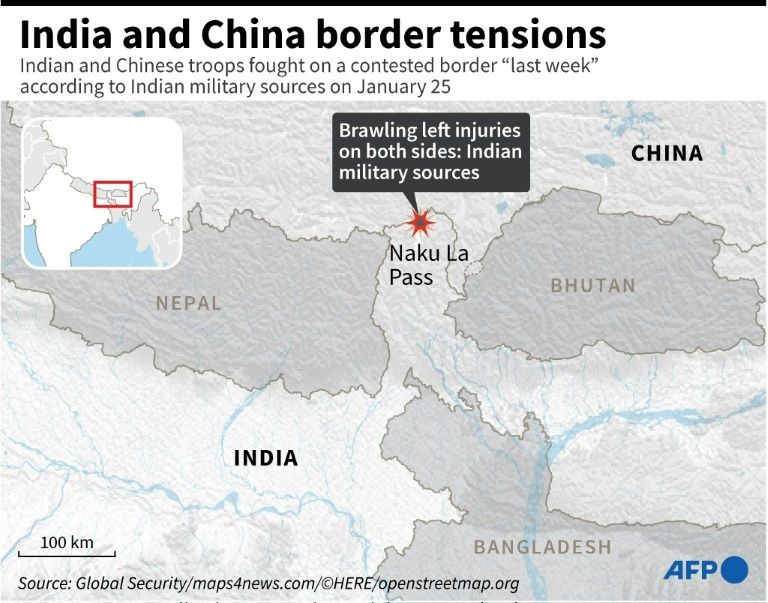India and China clash again on Himalayan border
New Delhi (AFP) – Indian and Chinese troops fought a new brawl on their contested Himalayan border that left injuries on both sides, officials said Monday, highlighting the fraught state of relations between the giant neighbours.
The fighting on January 20 came six months after a pitched battle which left at least 20 Indian troops dead as well as an unknown number of Chinese casualties.
The world’s two most populous nations have since become embroiled in a diplomatic showdown over their geographical and political differences.
India’s military played down the latest skirmish as a “minor face-off” at Naku La pass, which connects Sikkim state with Tibet on the Chinese side.
China’s foreign ministry, however, said it had “no information” on the incident.
In a statement, the Indian army said last week’s clash was “resolved by local commanders as per established protocols”.
Government sources said four Indian troops were injured when a Chinese patrol was forced back. They added that China’s People’s Liberation Army suffered an unknown number of casualties.
In Beijing, foreign ministry spokesman Zhao Lijian said Chinese troops “dedicated themselves to safeguarding the peace and tranquillity” of the border region”.
“China urges India to work in the same direction,” he said.
– Firearms banned –
Details of the latest clash emerged on the eve of India’s Republic Day, when the country shows off its latest military hardware at a parade in the capital.
Hand-to-hand fighting between 150 soldiers at Naku La in May also set off tensions.
About 10 troops from each side were injured.
The use of firearms by border patrols is banned under a bilateral agreement.
In June, troops fought with fists and wooden clubs in the Galwan valley of Ladakh region, leaving dozens dead. China has never confirmed it suffered fatalities.
A number of the Indian troops killed were expected to receive posthumous awards on Republic Day.
China and India, who fought a border war in 1962, blame each other for the increased tensions and each has poured tens of thousands of extra troops into border zones.
The latest de-escalation talks between military commanders were held Sunday, but there have been no signs that either side is ready to back down.
India’s Foreign Minister Subrahmanyam Jaishankar said last month that relations between the neighbours had been “significantly damaged” by events of the past year.
India is also wary of China’s moves to extend its diplomatic muscle into South Asia through massive investment schemes.
The government has sought to block Chinese companies from getting deals in India, banning more than 150 Chinese apps made by its tech giants.
Chinese products are being halted in customs logjams at Indian ports. China has in turn warned that India will suffer economically from the dispute.
Harsh Pant, a professor of international relations at Kings College in London said the Sikkim brawl showed “there is a real stalemate on the border”.
He said Beijing was “looking for different pressure points” in the region.
On a broader level, Pant said the Himalayas were “just another theatre in the larger global picture for Beijing”.
“It is testing the waters with the new administration of US President Joe Biden. Earlier it used to be just Taiwan or South China Sea but now even the Himalayas (with India) are a part of that.
“They want to see how Biden administration will react on these multiple fronts simultaneously or individually,” said Pant.
Disclaimer: Validity of the above story is for 7 Days from original date of publishing. Source: AFP.


